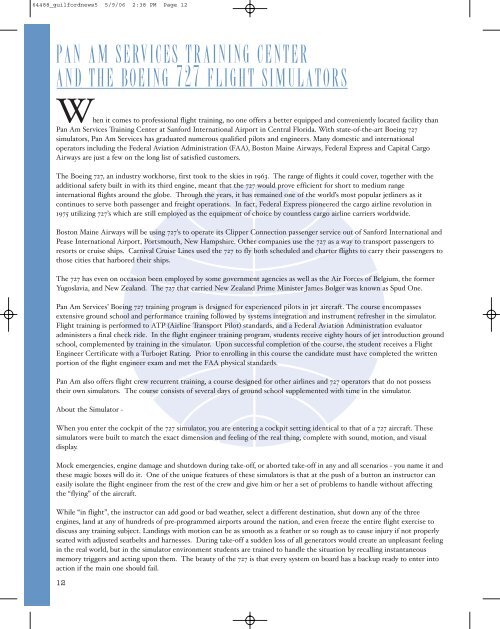You also want an ePaper? Increase the reach of your titles
YUMPU automatically turns print PDFs into web optimized ePapers that Google loves.
64488_guilfordnews5 5/9/06 2:38 PM Page 12<br />
pan am services training center<br />
and the boeing 727 flight simulators<br />
When it comes to professional flight training, no one offers a better equipped and conveniently located facility than<br />
<strong>Pan</strong> <strong>Am</strong> Services Training Center at Sanford International Airport in Central Florida. With state-of-the-art Boeing 727<br />
simulators, <strong>Pan</strong> <strong>Am</strong> Services has graduated numerous qualified pilots and engineers. Many domestic and international<br />
operators including the Federal Aviation Administration (FAA), Boston Maine Airways, Federal Express and Capital Cargo<br />
Airways are just a few on the long list of satisfied customers.<br />
The Boeing 727, an industry workhorse, first took to the skies in 1963. The range of flights it could cover, together with the<br />
additional safety built in with its third engine, meant that the 727 would prove efficient for short to medium range<br />
international flights around the globe. Through the years, it has remained one of the world’s most popular jetliners as it<br />
continues to serve both passenger and freight operations. In fact, Federal Express pioneered the cargo airline revolution in<br />
1975 utilizing 727’s which are still employed as the equipment of choice by countless cargo airline carriers worldwide.<br />
Boston Maine Airways will be using 727's to operate its <strong>Clipper</strong> Connection passenger service out of Sanford International and<br />
Pease International Airport, Portsmouth, New Hampshire. Other companies use the 727 as a way to transport passengers to<br />
resorts or cruise ships. Carnival Cruise Lines used the 727 to fly both scheduled and charter flights to carry their passengers to<br />
those cities that harbored their ships.<br />
The 727 has even on occasion been employed by some government agencies as well as the Air Forces of Belgium, the former<br />
Yugoslavia, and New Zealand. The 727 that carried New Zealand Prime Minister James Bolger was known as Spud One.<br />
<strong>Pan</strong> <strong>Am</strong> Services’ Boeing 727 training program is designed for experienced pilots in jet aircraft. The course encompasses<br />
extensive ground school and performance training followed by systems integration and instrument refresher in the simulator.<br />
Flight training is performed to ATP (Airline Transport Pilot) standards, and a Federal Aviation Administration evaluator<br />
administers a final check ride. In the flight engineer training program, students receive eighty hours of jet introduction ground<br />
school, complemented by training in the simulator. Upon successful completion of the course, the student receives a Flight<br />
Engineer Certificate with a Turbojet Rating. Prior to enrolling in this course the candidate must have completed the written<br />
portion of the flight engineer exam and met the FAA physical standards.<br />
<strong>Pan</strong> <strong>Am</strong> also offers flight crew recurrent training, a course designed for other airlines and 727 operators that do not possess<br />
their own simulators. The course consists of several days of ground school supplemented with time in the simulator.<br />
About the Simulator -<br />
When you enter the cockpit of the 727 simulator, you are entering a cockpit setting identical to that of a 727 aircraft. These<br />
simulators were built to match the exact dimension and feeling of the real thing, complete with sound, motion, and visual<br />
display.<br />
Mock emergencies, engine damage and shutdown during take-off, or aborted take-off in any and all scenarios - you name it and<br />
these magic boxes will do it. One of the unique features of these simulators is that at the push of a button an instructor can<br />
easily isolate the flight engineer from the rest of the crew and give him or her a set of problems to handle without affecting<br />
the “flying” of the aircraft.<br />
While “in flight”, the instructor can add good or bad weather, select a different destination, shut down any of the three<br />
engines, land at any of hundreds of pre-programmed airports around the nation, and even freeze the entire flight exercise to<br />
discuss any training subject. Landings with motion can be as smooth as a feather or so rough as to cause injury if not properly<br />
seated with adjusted seatbelts and harnesses. During take-off a sudden loss of all generators would create an unpleasant feeling<br />
in the real world, but in the simulator environment students are trained to handle the situation by recalling instantaneous<br />
memory triggers and acting upon them. The beauty of the 727 is that every system on board has a backup ready to enter into<br />
action if the main one should fail.<br />
12



